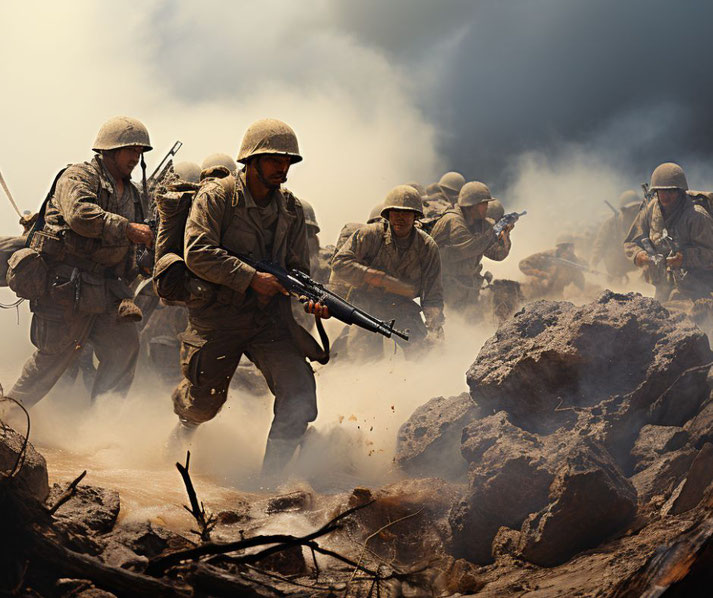The Battle of Inchon and its decisive role in the Korean War

On a quiet September morning in 1950, the calm waters near the South Korean city of Inchon became the stage for one of the most audacious and game-changing operations in modern military history.
Orchestrated by General Douglas MacArthur, the Battle of Inchon was a bold military maneuver designed to alter the trajectory of the Korean War.
But what drove MacArthur to choose Inchon, known for its treacherous tides and formidable defenses, as the landing site?
How did this high-risk operation manage to catch the North Korean forces off guard, and what were the consequences for the war's progress?
Why the Americans were involved in the Korean War
The Korean War, a conflict that erupted in the early years of the Cold War, began on June 25, 1950, when North Korean forces, equipped with Soviet tanks, crossed the 38th parallel into South Korea.
This invasion was the culmination of rising tensions on the Korean Peninsula, a region left divided after World War II.
The North, led by Kim Il-sung and backed by the Soviet Union and later China, adhered to communist ideologies, while the South, under the leadership of Syngman Rhee and supported by the United States and other Western nations, embraced a capitalist and democratic framework.
The swift advance of the North Korean People's Army (KPA) caught the South Korean forces and their American allies by surprise, leading to a rapid southward push.
By early August, the KPA had conquered much of South Korea, cornering the United Nations (UN) and South Korean forces in a small defensive perimeter around the port city of Pusan.
This desperate situation prompted the United States and other UN member states to escalate their military involvement, marking the first significant armed conflict of the Cold War era.
The Pusan Perimeter, established in August 1950, became a critical battleground. Despite being outnumbered and outgunned, the UN forces, predominantly composed of American troops, managed to hold their ground.
This defensive stand, while costly, provided a crucial buffer against the North Korean onslaught and bought time for a counteroffensive.

Why was Inchon chosen for the invasion?
By mid-1950, the United Nations forces, predominantly American, were confined to the Pusan Perimeter in the southeast corner of the Korean Peninsula.
General Douglas MacArthur, seeking a way to break the stalemate and relieve pressure on the Pusan Perimeter, proposed a daring amphibious assault on Inchon.
Inchon, a port city on the west coast of Korea, was strategically chosen for its proximity to Seoul, the capital of South Korea.
The recapture of Seoul was symbolically important but also tactically crucial for cutting North Korean supply lines.
However, the choice of Inchon was met with skepticism from many military leaders.
The city's harbor was notorious for its extreme tidal variations, narrow channels, and treacherous mudflats, making it a seemingly improbable location for a large-scale amphibious operation.
MacArthur was convinced that the very difficulties of an Inchon landing would ensure its success, as the North Koreans would not expect an attack there.
The element of surprise was central to the plan. To prepare for the operation, codenamed Operation Chromite, extensive reconnaissance and intelligence gathering were undertaken.
The planners meticulously studied the tidal patterns and topography of Inchon to devise a timetable that would allow the landing craft to navigate the hazardous waters.
The strategy also involved a complex coordination of naval, air, and ground forces.
The plan called for a preliminary bombardment by air and naval forces to weaken North Korean defenses before the landing.
The timing was crucial; the assault had to be synchronized with the tides to ensure the landing craft could reach the shore.
Any miscalculation could have left landing craft stranded or exposed to enemy fire.
The operation was a logistical challenge, requiring the mobilization of a large number of troops and equipment across the Pacific.
The element of secrecy was paramount; extensive efforts were made to deceive the North Korean forces about the intended location of the invasion.
How strong were the two sides?
The United Nations command, under the leadership of General Douglas MacArthur, orchestrated the Inchon operation.
The primary assault force was the U.S. X Corps, which included the 1st Marine Division, led by Major General Oliver P. Smith, and the Army's 7th Infantry Division, commanded by Major General David G. Barr.
These forces were seasoned, well-trained, and equipped with a range of support, including naval and air units.
The U.S. Navy's Seventh Fleet, under Vice Admiral Arthur D. Struble, played a crucial role in providing naval gunfire support and ensuring the safe landing of troops.
Additionally, the operation involved a multinational contingent, with forces from countries like the United Kingdom, Canada, and Australia participating under the UN banner.
The North Korean forces defending Inchon and its surrounding areas were part of the KPA, which had been established with Soviet assistance after World War II.
By the time of the Inchon landing, the KPA had already seen extensive action in the war, having pushed far into South Korea before being driven back by UN forces.
The KPA units in the Inchon area were not as heavily fortified or as well-prepared as in other regions, partly due to the belief that the challenging tidal conditions at Inchon would deter any large-scale amphibious assault.
The KPA was equipped with a range of Soviet-made weapons and had shown itself to be a formidable force in earlier engagements.
However, they were stretched thin across the peninsula, and their focus was primarily on the Pusan Perimeter in the south, leaving the Inchon area relatively vulnerable.
The dramatic events on the day of the invasion
The assault began on the 15th of September 1950, with a pre-dawn aerial and naval bombardment targeting North Korean defenses.
This preliminary attack was designed to soften enemy positions and create a path for the invading forces.
The bombardment was intense, with ships of the U.S. Navy Seventh Fleet, including battleships, cruisers, and destroyers, unleashing a barrage of artillery fire.
Simultaneously, aircraft from the U.S. Air Force and Navy pounded North Korean positions, further weakening their ability to mount a robust defense.
As the bombardment concluded, the first wave of U.N. forces, primarily U.S. Marines, began their assault.
The timing was meticulously planned to coincide with the tide, allowing landing craft to navigate the challenging tidal conditions of Inchon's harbor.
The Marines faced the daunting task of overcoming the seawall, a significant obstacle that required the use of ladders and ropes.
Regardless, they managed to secure a beachhead with relatively light resistance, as the North Korean defenders were caught off guard and overwhelmed by the scale and intensity of the attack.
Following the initial landing, more troops and equipment were brought ashore, including elements of the U.S. Army's 7th Infantry Division.
The U.N. forces quickly expanded their beachhead and began moving inland, encountering sporadic resistance from North Korean troops, who were disorganized and ill-prepared for such an assault.
By the evening of September 15, the U.N. forces had secured Inchon and began preparing for the next phase of the operation: the advance towards Seoul.
Despite facing pockets of resistance, the UN forces were able to take control of Inchon within the first 24 hours.
The swift capture of the city was a significant achievement, providing a strategic foothold for further operations, but it came at a cost.
The U.S. forces reported over 200 killed and around 800 wounded. The careful planning, element of surprise, and overwhelming firepower contributed to keeping the casualty numbers lower than what might have been expected from such a large-scale operation.
On the North Korean side, the losses were significantly higher. The North Korean People's Army (KPA) suffered heavy casualties, with estimates ranging from several thousand to over 10,000 killed and wounded.
The march on Seoul
With Inchon secured, the focus shifted to the recapture of Seoul. The UN forces began their advance towards the South Korean capital, encountering stiffer resistance as they moved closer to Seoul.
The North Korean forces, recovering from the initial shock of the Inchon landing, regrouped and mounted a determined defense of the city.
The subsequent battle for Seoul was the most intense phase of the operation. Urban combat posed significant challenges, with house-to-house fighting and snipers causing casualties on both sides.
The UN forces, primarily U.S. Marines and Army units, methodically cleared the city, facing fierce resistance from North Korean troops determined to hold Seoul.
The battle was marked by heavy fighting, but the superior firepower and coordination of the UN forces eventually prevailed.
On September 26, Seoul was officially declared liberated. The recapture of the capital was a major symbolic and strategic victory for the UN forces.
It not only bolstered the morale of the South Korean government and its allies but also marked a significant turning point in the war, forcing North Korean forces to retreat northward.

How important was the Battle of Inchon in the war?
Prior to Inchon, the situation for the United Nations forces was precarious. They were confined to the Pusan Perimeter in the southeastern corner of the Korean Peninsula, under constant pressure from North Korean forces.
The successful landing at Inchon and the subsequent recapture of Seoul not only relieved the besieged UN forces at Pusan but also forced the North Korean People's Army (KPA) into a hasty and disorganized retreat.
This reversal was stark; the KPA, which had been on the brink of uniting the peninsula under North Korean rule, found itself on the defensive.
The psychological impact of the Inchon landing and the fall of Seoul was immense. For the South Korean government and its people, the liberation of Seoul was a significant morale booster.
It demonstrated the commitment of the United Nations to the South Korean cause and restored confidence in the possibility of repelling the North Korean invasion.
For the North Korean regime and its forces, the loss was a significant blow, undermining the perception of their invincibility and diminishing their momentum.
Strategically, the success at Inchon opened up new possibilities for the United Nations Command.
With the North Korean forces in retreat, General MacArthur was able to pursue them north of the 38th parallel, the line that had originally divided North and South Korea.
This shift in strategy aimed not just at repelling the invasion but at unifying Korea under the South Korean government.
It led to the entry of Chinese forces into the war in late October 1950, a development that would escalate the conflict and draw it out for several more years.
What do you need help with?
Download ready-to-use digital learning resources
Copyright © History Skills 2014-2025.
Contact via email
With the exception of links to external sites, some historical sources and extracts from specific publications, all content on this website is copyrighted by History Skills. This content may not be copied, republished or redistributed without written permission from the website creator. Please use the Contact page to obtain relevant permission.





